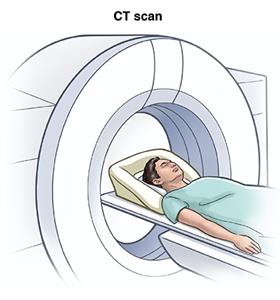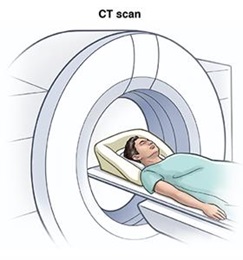Vascular Dementia
What is vascular dementia?
Vascular dementia is the second most common form of dementia after Alzheimer disease. It's caused when decreased blood flow damages brain tissue. Blood flow to brain tissue may be reduced. Or it may be completely blocked by a blood clot.
Symptoms of vascular dementia may develop slowly. Or they may develop after a stroke or major surgery, such as heart bypass surgery or abdominal surgery.
Dementia and other related diseases and conditions are hard to tell apart because they share similar symptoms. Vascular dementia is caused by problems with blood flow to the brain. But this blood flow problem can develop in different ways. Examples of vascular dementia include:
-
Mixed dementia. This type occurs when symptoms of both vascular dementia and Alzheimer exist.
-
Multi-infarct dementia. This occurs after repeated small, often "silent," blockages affect blood flow to certain parts of the brain. The changes that occur after each blockage may not be apparent. But over time, the combined effect starts to cause symptoms. This is also called vascular cognitive impairment.
The effect of decreased or no blood flow on the brain depends on the size and location of the area affected. If a small area in a part of the brain that controls memory is affected, you may be "forgetful." But this doesn't always change your ability to do normal activities. If a larger area is affected, you may have trouble thinking clearly or solving problems. These problems may change your ability to function normally.
Researchers think that vascular dementia will become more common in the next few decades because:
-
Vascular dementia is generally caused by conditions that occur most often in older people. These include hardening of the arteries (atherosclerosis), heart disease, and stroke.
-
The number of people older than age 65 is growing.
-
People are living longer with long-term (chronic) diseases, such as heart disease and diabetes.
What causes vascular dementia?
This disease is caused by a lack of blood flow to a part of the brain. Blood flow may be decreased or interrupted by:
-
Blood clots
-
Bleeding because of a ruptured blood vessel (such as from a stroke)
-
Damage to a blood vessel from atherosclerosis, infection, high blood pressure, or other causes, such as an autoimmune disorder
- CADASIL (cerebral autosomal dominant arteriopathy with sub-cortical infarcts and leukoencephalopathy) is a genetic disorder that generally leads to dementia of the vascular type. One parent with the gene for CADASIL passes it on to a child, which makes it an autosomal-dominant inheritance disorder. It affects the blood vessels in the white matter of the brain. Symptoms, such as migraine headaches, seizures, and severe depression, generally start when a person is in his or her mid-30s; but, symptoms may not appear until later in life.
Who is at risk for vascular dementia?
Risk factors for vascular dementia include risk factors for the conditions linked to it (heart disease, stroke, diabetes, and atherosclerosis):
-
Older age
-
High blood pressure
-
Smoking
-
High cholesterol and triglyceride levels
-
Diabetes
-
Metabolic syndrome
-
Atrial fibrillation. This is fast and irregular heart rate of the upper 2 heart chambers.
-
High level of homocysteine in the blood. This can cause damage to blood vessels, heart disease, and blood clots.
-
Lack of physical activity
-
Overweight
-
Birth control pills
-
Conditions that cause the blood to "thicken" (clot) more easily
-
Family history of dementia
-
Family history of CADASIL
What are the symptoms of vascular dementia?
The symptoms of vascular dementia depend on the location and amount of brain tissue involved. They may appear suddenly after a stroke, or slowly over time. Symptoms may get worse after another stroke, a heart attack, or major surgery. These are symptoms of vascular dementia:
-
Increased trouble doing normal daily activities because of problems with focus, communication, or inability to carry out directions
-
Memory problems. Short-term memory may not be affected.
-
Confusion, which may get worse at night (called sundown syndrome)
-
Stroke symptoms, such as sudden weakness and trouble with speech
-
Personality changes
-
Mood changes, such as depression or irritability
-
Stride changes when walking too fast or shuffling steps
-
Problems with movement, balance. or both
-
Urinary problems, such as urgency or incontinence
-
Tremors
How is vascular dementia diagnosed?
Your healthcare provider will ask about your health history and do a physical exam. You may also need some of these tests:
-
Blood tests. These are done to look for other conditions causing your symptoms, such as vitamin deficiencies.
-
CT scan. This imaging test uses X-rays and a computer to make images of the brain. CT scans are more detailed than general X-rays.
-
FDG-PET scan . This is a PET scan of the brain that uses a special tracer to light up regions of the brain.
-
Electroencephalogram. This test measures electrical activity in the brain.
-
MRI. This test uses large magnets, radiofrequencies, and a computer to make detailed images of the brain.
-
Neuropsychological assessments. These tests can help sort out vascular dementia from other types of dementia and Alzheimer disease.
-
Lumbar puncture (Spinal tap). This is done to analyze cerebrospinal fluid for inflammation, infection, or other abnormalities. This can also be done to remove a large amount of fluid to see if there is any improvement.
-
Neuropsychiatric evaluation. This may be done to rule out a psychiatric condition that may look like dementia.
How is vascular dementia treated?
Vascular dementia can't be cured. The main goal is to treat the underlying conditions that affect the blood flow to the brain. This can help cut the risk for further damage to brain tissue.
Such treatments may include:
-
Medicines to manage blood pressure, cholesterol, triglycerides, diabetes, and problems with blood clotting
-
Lifestyle changes, such as a healthy diet, physical activity, quitting smoking, and stopping or decreasing alcohol use
-
Procedures to improve blood flow to the brain, such as carotid endarterectomy, angioplasty, and stenting. The carotid arteries are located in the neck and provide blood flow from the heart to the brain.
-
Medicines, such as cholinesterase inhibitors to treat the symptoms of dementia or antidepressants to help with depression or other symptoms
Living with vascular dementia
Vascular dementia gets worse over time and has no cure. But the rate at which the disease gets worse can vary. The disease can be stable for long periods of time. Some people with this disease may over time need a high level of care because of the loss of mental and physical abilities. Family members may be able to care for a person with vascular dementia early on. But if the disease progresses, the person may need more specialized care.
Respite programs, adult daycare programs, and other resources can help the caregiver get some time away from the demands of caring for a loved one with vascular dementia.
Long-term care facilities that specialize in caring for people with dementias, Alzheimer, and other related conditions are often available if a person affected by vascular dementia can no longer be cared for at home. Your healthcare provider can advise caregiver resources.
When should I call my healthcare provider?
People with vascular dementia and their caregivers should talk with their healthcare providers about when to call them. They will likely advise you to call if symptoms get worse. This can be obvious changes in behavior, personality, memory, or speech. You should also call if new symptoms appear. These can include sudden weakness, trouble speaking, or confusion.
Key points about vascular dementia
-
Vascular dementia is a disorder that damages brain tissue because of a lack of blood flow. Causes can include blood clots, ruptured blood vessels, or narrowing or hardening of blood vessels that supply the brain.
-
Symptoms can include problems with memory and focus, confusion, changes in personality and behavior, loss of speech and language skills, and sometimes physical symptoms, such as weakness or tremors.
-
Vascular dementia tends to get worse over time. Treatments can't cure the disease, but lifestyle changes and medicines to treat underlying causes might help slow its progress.
-
Surgery to improve blood flow to the brain can also be helpful. Other medicines might slow the progression of dementia or help with some of the symptoms it can cause.
-
A person with this disease may eventually need full-time nursing care or to stay in a long-term care facility.
Next steps
Tips to help you get the most from a visit to your healthcare provider:
-
Know the reason for your visit and what you want to happen.
-
Before your visit, write down questions you want answered.
-
Bring someone with you to help you ask questions and remember what your provider tells you.
-
At the visit, write down the name of a new diagnosis, and any new medicines, treatments, or tests. Also write down any new directions your provider gives you.
-
Know why a new medicine or treatment is prescribed, and how it will help you. Also know what the side effects are.
-
Ask if your condition can be treated in other ways.
-
Know why a test or procedure is recommended and what the results could mean.
-
Know what to expect if you do not take the medicine or have the test or procedure.
-
If you have a follow-up appointment, write down the date, time, and purpose for that visit.
-
Know how you can contact your healthcare provider if you have questions, especially after office hours or on weekends.





